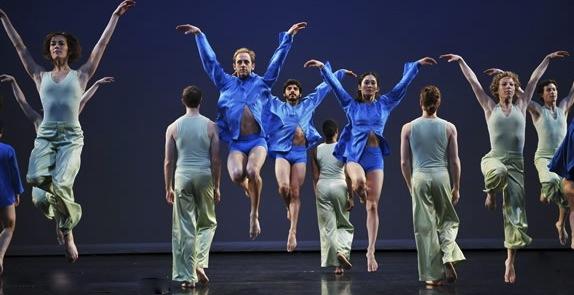I try to remember when I first saw Mark Morris’s dance company and what I thought of them. Fairly weird, I recall - like chubby church-goers, with their big bottoms, fleshy arms and homespun cheeriness, not remotely part of the sharp-boned, athletically wired contemporary dance that was all around. And they weren’t balletic either, despite their little village hall arabesques and occasional flying jetés. But by gum what they did was musical, and that smacked you straightaway.
The dance world is even leaner and more chicken-jointed now, and musical understanding has virtually dropped out of general existence. (Has contemporary dance and its audience ever been as unmusical as it is now?) I admit I arrived at Sadler’s Wells pretty downbeat, having been put through M25 hell and thus missed entry to his latest new work, Empire Garden. But the fact that I was so angry about missing Morris’s latest is a mark of the eager anticipation this unique American choreographer generates - wag, scatological cherub, lyric tragedian, music devotee.
Morris is famously pro unorthodox bodies, so his performers look as if they’d all been picked at random off the street in multiple variety, and what they offer is rough-edged, individual dancing. You got that especially in Bedtime, on the first programme of the two he has taken to London this week, which looks like a celebration of children’s bedtime, from the deep peace of blameless sleep to the ways little ones cope with nightmares. Dressed in awful cap-sleeved Nineties pyjamas - the piece is 17 years old - it’s a children’s dance in the sense that Philip Pulman or Dennis Potter does children’s writing: ie refracted from what seems a very grown-up awareness of everything makes childhood both fantastically carefree and fantastically scary.
Three Schubert songs accompany this little gem: a lullaby, "Wiegenlied", where (as it might be) three children sleep, three parents wait, and an angel dances sweetly around their metaphorical bedheads; then a jolly, time-for-bed skip-in to "Ständchen", and some pretend sleeping with a naughty foot stuck up; finally a pantomime for "The Erl King" which dissipates the fright of the story by having everyone energetically pretend to be a demon or the child or the dad or the Erl King’s evil daughters. That two of the “children” are bearded, and another is as highly muscled as a sprinter, and there’s some quite lewd grins to be seen here and there, detracts not the slightest. As a portrait of children it doesn’t make a false step. Naive-looking as its physical materials are, Morris’s dance is psychologically cunning, and musically it offers some lovely grace-notes that Schubert would surely understand.
V (the Roman number for five, set to Schumann’s string quintet) has a similar Morrisish joke in it, in that while this is a work on a grand and seriously musical scale, half the dancers are stuck in big blue pants and split shirts over hairy bare legs. This irreverent costuming, oddly enough, underscores just what a richly beautiful and thought-out dance it is. Made for Sadler's Wells in 2001, V is already a Morris classic.
There’s so much in this quintet that is really undanceable, if you listen to it alone - the opening declamatory chords, the energetically palate-cleansing scherzo, the garrulously chattering start to the last movement, and the sudden switches of mood from turbulence to serenity. These things only work in music. But often, watching what Morris has choreographed, you may feel that surely no other choreographer alive would have such confidence and sensitivity to let the dance here and there pale out, become deliberately a minor voice inside the quintet when the music is too much, as if it were switching the dancers momentarily to the pit and the musicians to the stage.
The two tribes, the big pants brigade and a pale-green lot in bellbottoms, do smart little formation jumps, like a ballet troupe, or suddenly sway their hips and hug themselves, like music fans lost in their own rapture in a moshpit. There’s a repeated, melodramatic motif, where girls fling themselves backwards and upwards onto boys’ shoulders and freeze. Perhaps they're abandoning themselves, blindly hoping someone will catch them (metaphor for the company's peripatetic existence), or perhaps they're just enjoying doing a sforzando dance-style.
Most striking of all, who but Morris, with his baroque imagination and love of surprises, would be so bold as to have a kissing couple at the start of the slow movement be torn apart by a horror-film transformation, as one slips to the ground and starts crawling like an insect? The crawling becomes a mass movement, from which, on secret signals, some are chosen and allowed to rise uprights like human beings from the slime.
This grotesque motif, as the stage fills with ant-like creatures, elbows and joints aggressive and sharp, makes a disturbing, pathetic impact, almost a despairing comment on humanity - as if Morris was ever likely to do such a thing.
The evening would have only half such pleasure if it were not for the five superb musicians playing the Schumann (despite the tinny piano), and a crisp neat performance by their vocal colleagues in the Schubert.
- This programme is repeated tomorrow and Saturday; tonight programme 2, also on Friday. Book online here.
- The company tours on to Plymouth Theatre Royal, 2 & 3 November; Edinburgh Festival Theatre, 6 & 7 November; Wales Millennium Centre, Cardiff, 10 & 11 November; Newcastle Theatre Royal, 13 & 14 November; Snape Maltings Concert Hall, 20 & 21 November. Company website here














Add comment